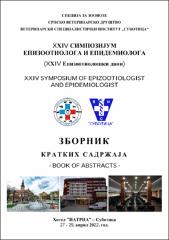| dc.contributor.author | Lupulović, Diana | |
| dc.contributor.author | Petrović, Tamaš | |
| dc.contributor.author | Lazić, Gospava | |
| dc.contributor.author | Samojlović, Milena | |
| dc.contributor.author | Gajdov, Vladimir | |
| dc.contributor.author | Pajić, Marko | |
| dc.contributor.author | Knežević, Slobodan | |
| dc.contributor.author | Đurđević, Biljana | |
| dc.contributor.author | Rekecki, Tibor | |
| dc.contributor.author | Mirčeta, Jovan | |
| dc.contributor.author | Lazić, Sava | |
| dc.date.accessioned | 2022-05-12T09:12:57Z | |
| dc.date.available | 2022-05-12T09:12:57Z | |
| dc.date.issued | 2022-04-27 | |
| dc.identifier.isbn | 978-86-83115-45-7 | |
| dc.identifier.uri | https://repo.niv.ns.ac.rs/xmlui/handle/123456789/498 | |
| dc.description.abstract | Avian influenza (AI) or “bird flu” is highly contagious viral disease caused by avian
influenza viruses type A (AIV). The AIV primarily infects wild birds, but the virus
can affect also domestic poultry causing enormous economic loses. Avian influenza
is a zoonotic disease, although human infections are rare, there have been recorded
severe complications with fatal outcome. Based on the molecular characterization and
upon the severity of clinical signs in poultry, avian influenza viruses are classified
into: highly pathogenic avian influenza (HPAI) and low pathogenic avian influenza
(LPAI) viruses.
The first incursion of HPAI H5N1 was detected in Serbia in mute swans in 2006,
followed by epidemics in 2016/2017. Since then, AIV is circulating in this region and
poses a threat for human health. The aim of this study was to investigate the presence
of AIV in various wild birds which represent the reservoir of AIV, in the water habitats
of the Vojvodina Province (Serbia), as well as to determine their importance in virus
dissemination in the region.
In total, 610 samples from wild birds were collected from the 1StNovember 2020 till
31st March 2022, during the IPA cross-border project Hungary-Serbia and Monitoring
program of Avian influenza in poultry and wild birds in Republic of Serbia, that was
launched by the Veterinary Directorate of RS. The sampling territory encompasses
aquatic landscapes in the special nature reserves, hunting grounds and river coasts in
the Vojvodina Province. The specimens represented: cloacal swabs, tracheal swabs,
bird carcasses of found dead or shot birds and pooled faeces from the coastal areas.
The samples belonged to 56 different bird species. For detection of AIV genome was
used real-time RT-PCR to determine matrix gene (M), and H5 and H7 subtypes.
Laboratory analyses confirmed the presence of AIV RNA in 18 out of 610 tested
samples (2.95%, 18/610). The AIV genome was identified in three waterfowl bird
species (mallard duck, mute swan and gull), collected from 10 different locations. The
results of our research have proven the presence of AIV in wild birds in Voјvodina
Province. Furthermore, it is necessary to implement continuous surveillance program
for the protection of public health against the new emergency of AIV in future. | en_US |
| dc.description.sponsorship | This study was financed by Ministry of Education, Science and Technological development of
Republic of Serbia by the Contract of implementation and funding of research work of NIV-NS in 2022, Contract
No: 451-03-68/2022-14/200031 | en_US |
| dc.language.iso | other | en_US |
| dc.publisher | SVD, Sekcija za zoonoze, Beograd (Srbija) | en_US |
| dc.source | Zbornik kratkih sadržaja, XXIV Simpozijum epizootiologa i epidemiologa (XXIV Epizootiološki dani), Subotica | sr |
| dc.subject | Avian influenza | en_US |
| dc.subject | wild birds | en_US |
| dc.subject | zoonotic disease | en_US |
| dc.subject | Vojvodina Province | en_US |
| dc.title | Avijarna influenca kod divljih ptica u Pokrajini Vojvodini 2020-2022 | en_US |
| dc.title.alternative | Avian influenza in wild birds in the Vojvodina Province 2020-2022 | en_US |
| dc.title.alternative | | en_US |
| dc.type | Article | en_US |

